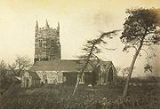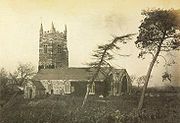
Egloskerry
Encyclopedia
Egloskerry is a village and civil parish in east Cornwall
, United Kingdom
. It is situated approximately five miles (8 km) northwest of Launceston.
Egloskerry parish consists of the village itself and many outlying hamlets and farms, including Tregeare, Badharlick
and Trebeath. There are 3253 acres (13.2 km²) of land and 9 acres (36,421.7 m²) of water in the parish.
of 1801, the parish had 307 inhabitants. The population increased to a peak in 1841, when 552 people were recorded in the parish. Thereafter, the population steadily decreased to its lowest point of only 275 people in 1981. Since then, there has been a consistent increase in people living in the parish, with 374 persons residing there in 2001.
with original Norman wall and transept. The Penheale Estate is located within the parish and Penheale was mentioned as one of 284 manors in Cornwall by the Domesday Book
The Penheale Estate is located within the parish and Penheale was mentioned as one of 284 manors in Cornwall by the Domesday Book
of 1086. The Rev. Henry Addington Simcoe, son of John Graves Simcoe
, purchased the estate in 1830 and was curate
of Egloskerry from 1822 to 1846. He was married twice and had eleven children. Simcoe wrote and published many books from his own printing press at Penheale. He died at the manor house on 15 November 1868 and was buried in the village churchyard five days later.
The manor house of Penheale, a mile from the village, is early 17th century though on the site of a mediaeval house. During the 1920s, Norman Colville acquired Penheale and made extensive renovations and additions through the assistance of the famous English architect, Sir Edwin Lutyens. The original house can be dated to ca. 1620-1640, part of the gatehouse late 18th century: Lutyens's extension is to the south.
closed entirely.
Hardy, Thomas (2005), A Pair of Blue Eyes, Oxford University Press, 320.
Trevena, John (1908), Heather, Alston Rivers
, London, 424.
Trevena also mentions the rail station at Egloskerry in First and Last Loves
Cornwall
Cornwall is a unitary authority and ceremonial county of England, within the United Kingdom. It is bordered to the north and west by the Celtic Sea, to the south by the English Channel, and to the east by the county of Devon, over the River Tamar. Cornwall has a population of , and covers an area of...
, United Kingdom
United Kingdom
The United Kingdom of Great Britain and Northern IrelandIn the United Kingdom and Dependencies, other languages have been officially recognised as legitimate autochthonous languages under the European Charter for Regional or Minority Languages...
. It is situated approximately five miles (8 km) northwest of Launceston.
Egloskerry parish consists of the village itself and many outlying hamlets and farms, including Tregeare, Badharlick
Badharlick
Badharlick is a hamlet in Cornwall, situated half way between the villages of Tregeare and Egloskerry....
and Trebeath. There are 3253 acres (13.2 km²) of land and 9 acres (36,421.7 m²) of water in the parish.
Population
During the earliest censusCensus
A census is the procedure of systematically acquiring and recording information about the members of a given population. It is a regularly occurring and official count of a particular population. The term is used mostly in connection with national population and housing censuses; other common...
of 1801, the parish had 307 inhabitants. The population increased to a peak in 1841, when 552 people were recorded in the parish. Thereafter, the population steadily decreased to its lowest point of only 275 people in 1981. Since then, there has been a consistent increase in people living in the parish, with 374 persons residing there in 2001.
History of Egloskerry and Penheale
In the village is the 15th century church of St. Keri and St. PetrocSaint Petroc
Saint Petroc is a 6th century Celtic Christian saint. He was born in Wales but primarily ministered to the Britons of Dumnonia which included the modern counties of Devon , Cornwall , and parts of Somerset and Dorset...
with original Norman wall and transept.

Domesday Book
Domesday Book , now held at The National Archives, Kew, Richmond upon Thames in South West London, is the record of the great survey of much of England and parts of Wales completed in 1086...
of 1086. The Rev. Henry Addington Simcoe, son of John Graves Simcoe
John Graves Simcoe
John Graves Simcoe was a British army officer and the first Lieutenant Governor of Upper Canada from 1791–1796. Then frontier, this was modern-day southern Ontario and the watersheds of Georgian Bay and Lake Superior...
, purchased the estate in 1830 and was curate
Curate
A curate is a person who is invested with the care or cure of souls of a parish. In this sense "curate" correctly means a parish priest but in English-speaking countries a curate is an assistant to the parish priest...
of Egloskerry from 1822 to 1846. He was married twice and had eleven children. Simcoe wrote and published many books from his own printing press at Penheale. He died at the manor house on 15 November 1868 and was buried in the village churchyard five days later.
The manor house of Penheale, a mile from the village, is early 17th century though on the site of a mediaeval house. During the 1920s, Norman Colville acquired Penheale and made extensive renovations and additions through the assistance of the famous English architect, Sir Edwin Lutyens. The original house can be dated to ca. 1620-1640, part of the gatehouse late 18th century: Lutyens's extension is to the south.
North Cornwall Railway
Egloskerry railway station opened on 3 October 1892 when the London & South Western Railway, or LSWR, opened a line between Launceston and Tresmeer. The small goods yard at the station closed on 9 May 1960 and the station completely a few years later. On 3 October 1966, the line that passed through EgloskerryNorth Cornwall Railway
The North Cornwall Railway was a railway line running from Halwill in Devon to Padstow in Cornwall via Launceston, Camelford and Wadebridge, a distance of 49 miles 67 chains. Opened in the last decade of the nineteenth century, it was part of a drive by the London and South Western Railway to...
closed entirely.
Literary references
- Thomas HardyThomas HardyThomas Hardy, OM was an English novelist and poet. While his works typically belong to the Naturalism movement, several poems display elements of the previous Romantic and Enlightenment periods of literature, such as his fascination with the supernatural.While he regarded himself primarily as a...
, in Chapter 36 of A Pair of Blue EyesA Pair of Blue EyesA Pair of Blue Eyes is a novel by Thomas Hardy, published in 1873.The book describes the love triangle of a young woman, Elfride Swancourt, and her two suitors from very different backgrounds. Stephen Smith is a socially inferior but ambitious young man who adores her and with whom she shares a...
first published in 1873:
"Why, the man in Hill Street, who plays and sells flutes, trumpets, and fiddles, and grand pianners. He was talking to Egloskerry, that very small bachelor-man with money in the funds. I was going by, I'm sure, without thinking or expecting a nod from men of that glib kidney..."
Hardy, Thomas (2005), A Pair of Blue Eyes, Oxford University Press, 320.
- In the second book, Heather, of a trilogy written by John Trevena (the pseudonym of Ernest George HenhamErnest George HenhamErnest George Henham was a Canadian-British author who wrote novels at the beginning of the 20th Century about Dartmoor and Devon, England. He also published literary works under the pseudonym John Trevena.-General Background:Ernest G...
) and published in 1908:
On a cold March day any traveller by the North Cornwall line may feel conceited as well as numbed. He shivers because the wind tries to shatter the windows from Egloskerry onwards; he is proud because he cannot think what the railway would do without him; for two or three shilings he has apparently bought the train, a rheumatic locomotive which wobbles and totters seawards, and a lot of little weather-beaten stations with two or three dummy men thrown in at each one, looking like Shems, Hams and Japhets standing on wooden plates all ready for the Ark.
Trevena, John (1908), Heather, Alston Rivers
Alston Rivers
Alston Rivers Ltd. was a London publishing firm. The firm originally consisted of the Hon L.J. Bathurst and R.B. Byles and had brought out the novels of Whyte Melville and the Gilbert and Sullivan operas. In 1904 it was reconstituted, with Bathurst and Archibald Marshall putting up the money and...
, London, 424.
- John BetjemanJohn BetjemanSir John Betjeman, CBE was an English poet, writer and broadcaster who described himself in Who's Who as a "poet and hack".He was a founding member of the Victorian Society and a passionate defender of Victorian architecture...
, in his 1960 autobiography Summoned by BellsSummoned by BellsSummoned by Bells, the blank verse autobiography by John Betjeman, describes his life from his early memories of a middle class home in Edwardian Hampstead, London, to his premature departure from Magdalen College, Oxford....
:
- The emptying train, wind in the ventilators,
- Puffs out of Egloskerry to Tresmeer
- Through minty meadows, under bearded trees
- And hills upon whose sides the clinging farms
- Hold Bible Christians. Can it really be
- That this same carriage came from Waterloo?
Trevena also mentions the rail station at Egloskerry in First and Last Loves
Green Southern Railway engines came right into the brown and cream Great Western district of Cornwall, to reach Padstow, Launceston, Egloskerry, Otterham, Tresmeer, Camelford -- and so on, down that windy single line. I know the stations by heart, the slate and granite-built waiting rooms, the oil lamps and veronica bushes.
Legal precedent
- In an 1898 opinion from the Queen's Bench titled Simcoe v. Pethick, certain property had been set aside for residents in the village of Egloskerry to remove turf, subject to oversight by the churchwardens and overseers of the poor. Pethick entered on the land and removed wood over the objection of the lord of the manor, Simcoe, the son of Rev. Henry Addington Simcoe, who claimed that he had the ownership rights to the land and to the removal of turf and wood. The court held that the churchwardens and overseers had the legal right to regulate the manner in which turf could be removed from the property, not the lord of the manor. Simcoe v. Pethick, 2 Q.B. 55(1898). The case was widely cited as an important precedent for public land rights in England.

